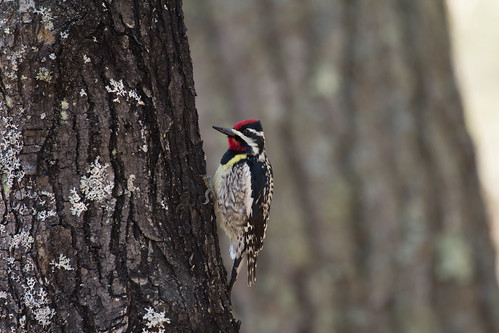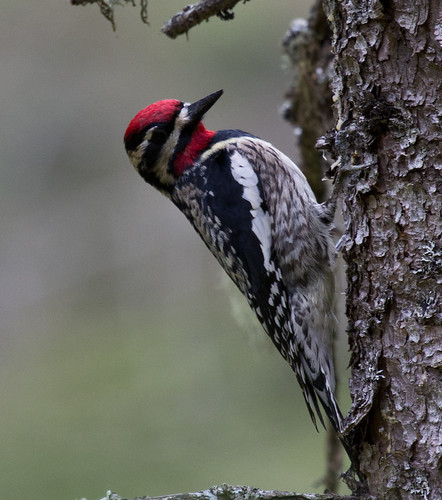 |
| Male Yellow-bellied Sapsucker |
One of my friends on facebook, who lives outside Chicago, was thrilled a few days ago when a Yellow-bellied Sapsucker spent a day in a conifer right outside her window. Jodie Cregier Nettelhorst reacted pretty much the way I do when I get a sapsucker in my yard. She said, “I feel so lucky. It sat on the tree for hours… [and] I sat for hours watching it. I thought for sure it would fly off before I got my camera out and ready so I waited for a long time. Then when the neighbors came and went and it still didn't fly off I decided to quit watching to get my camera. It was still there after my boys came home from school." Jodie wondered what brought to her yard a bird that neither winters nor breeds near her.
 |
| Jodie Cregier Nettelhorst's male Yellow-bellied Sapsucker as seen through her window. |
Birds don't have access to Star Trek's transporters—they can't just get beamed up from their winter to summer range—and April is the month when they pass through the vast in-between area. When their body is in shape and weather conditions are right, they migrate by night, depleting their fat stores to fuel the long journey. Wherever they find themselves in the morning, they settle in to rest and feed. When their fat stores are replenished, they head out once again.
 |
|
breed in the dark red, winter in the blue, and
simply pass through in the yellow.
|
Many woodpeckers move at least a bit from place to place between seasons, and a few species, such as Black-backed and Three-toed Woodpeckers, travel long distances in search of tree stands harboring the insects that attack diseased or burned trees.
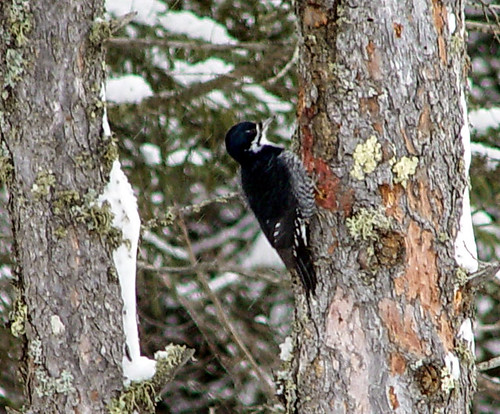 |
| Black-backed Woodpeckers like this one flake bark off diseased trees to get to the insects beneath. |
But very few woodpeckers undergo what we traditionally think of as standard bird migration, with annual movements between a northern breeding range and a non-overlapping southern winter range. Why so few? It takes time and work to dig out wood-boring beetle larvae and other prey insects deep in trees. By staying within the same area year-round, each woodpecker can keep track of the health of and insect-populations within lots of individual trees. Some woodpeckers, including Red-headed and Red-bellied, use acorns as an important food resource, storing a great many for future use. Acorn Woodpeckers are especially adapted for this. Sticking around in the same place allows them to protect and utilize those food stores.
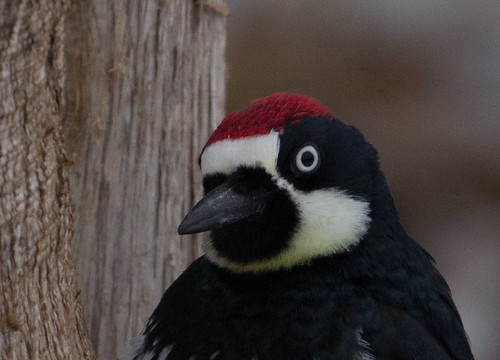 |
| Acorn Woodpecker |
Most woodpeckers roost in cavities that take many hours each to excavate and must be defended against invaders like flying squirrels and starlings. Investing all that time and energy in hard-won resources makes this group, as a whole, non-migratory.
Yet two woodpeckers, the Northern Flicker and Yellow-bellied Sapsucker, are regular migrants. Flickers are specially adapted for feeding on ants, which aren’t accessible when the ground freezes or is snow-covered, so they retreat south for the winter.
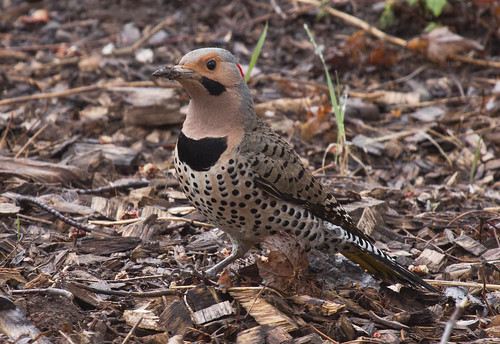 |
| Flickers feed on ants and other insects in the soil. |
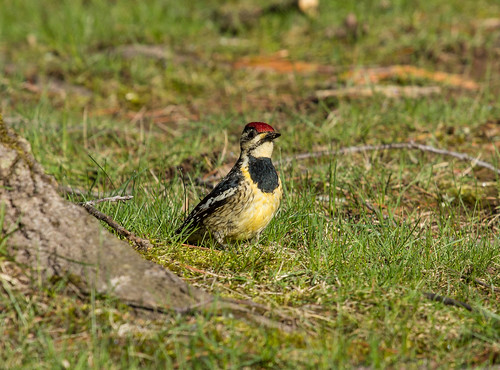 |
| Sapsuckers are functionally illiterate, and this one hasn't read that it's supposed to stay in trees. |
Our good old Yellow-bellied Sapsuckers return north as sap starts running in trees. They dig tiny ports around the trunk or a large limb, often in a perfect circle, and stick around most of the time, lapping up the sap that oozes out with their specialized, brushy-tipped tongue.
The sapsucker makes two kinds of holes for harvesting sap. Round holes extend deep in the tree and are not enlarged. Rectangular holes are shallower, and must be maintained continually for the sap to flow. New holes of either type are often made in line with old holes to encircle the trunk, and then the woodpecker starts a new row of holes above the old.The sapsucker licks the sap from these holes, and also eats the cambium of the tree and insects drawn to the sap.
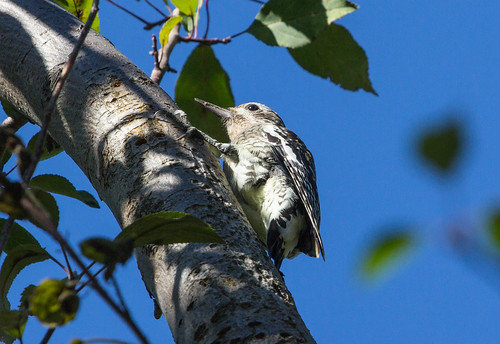 |
| If you look carefully, you can see tiny holes on this large limb. |
 |
| These shallow, rectangular holes must be maintained or the sap will stop running to them. |
The work involved in creating and defending these holes gives each sapsucker a vested interest in staying near them until it continues migration (the holes eventually seal up). Meanwhile, the quieter each one is, the less likely other birds will notice those drill holes and chase it off. Sapsuckers are pretty meek: I've seen birds as tiny as Cape May Warblers drive them away. This is why people seldom notice them during spring migration unless specifically looking for them.
Woodpecker species that show sexual dimorphism, meaning the males look different from females, virtually always show those plumage differences on their heads, which allows them to recognize each other's sex when one is inside a cavity with just the head sticking out.
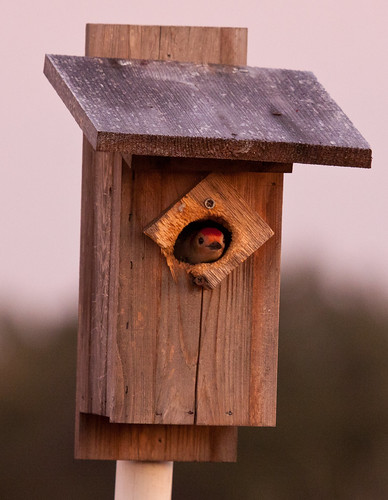 |
This Red-bellied Woodpecker can be recognized as a male by its
red forehead, easy to see even when it's within a cavity. |
Both male and female adult sapsuckers have red crowns, but males also have a red throat. (Young birds, which we'll see starting in June, lack red.) Some adults lack yellow bellies; those that do have yellow on the underside usually keep it hidden against tree trunks.
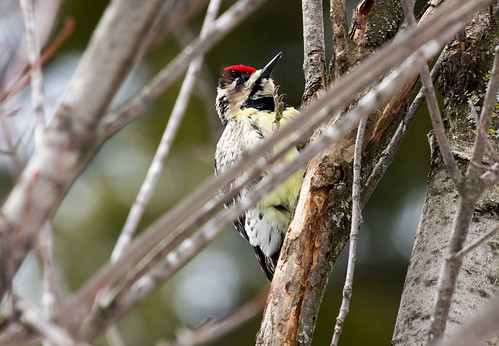 |
| If facing the right way on a narrow branch, you might get a peek at the yellow belly, like on this female. |
Although usually quiet on migration, lucky people may hear a sapsucker occasionally making its whiny mewing call, which is pretty easy to recognize. Those of us in the north woods where sapsuckers breed hear this sound a lot. Their territorial drumming sounds, only very rarely heard on migration, are exceptionally easy to recognize—they don’t have a steady rat-a-tat drum roll like other woodpeckers but a slower, much more arrhythmic one. Listen to the calls and sounds at
All About Birds here.
Any day now, I’m going to find my first backyard sapsucker feeding quietly in my aspen tree, where I’ve seen my first every year since 1981. During cold snaps, I might spot a Ruby-crowned Kinglet or Yellow-rumped Warbler at the drill holes. Crows carrying sticks; robins, grackles, and Killdeer are my first reliable signs that spring is really coming. But my first backyard Yellow-bellied Sapsucker is my official sign that spring has actually arrived, and all is right in my world.











